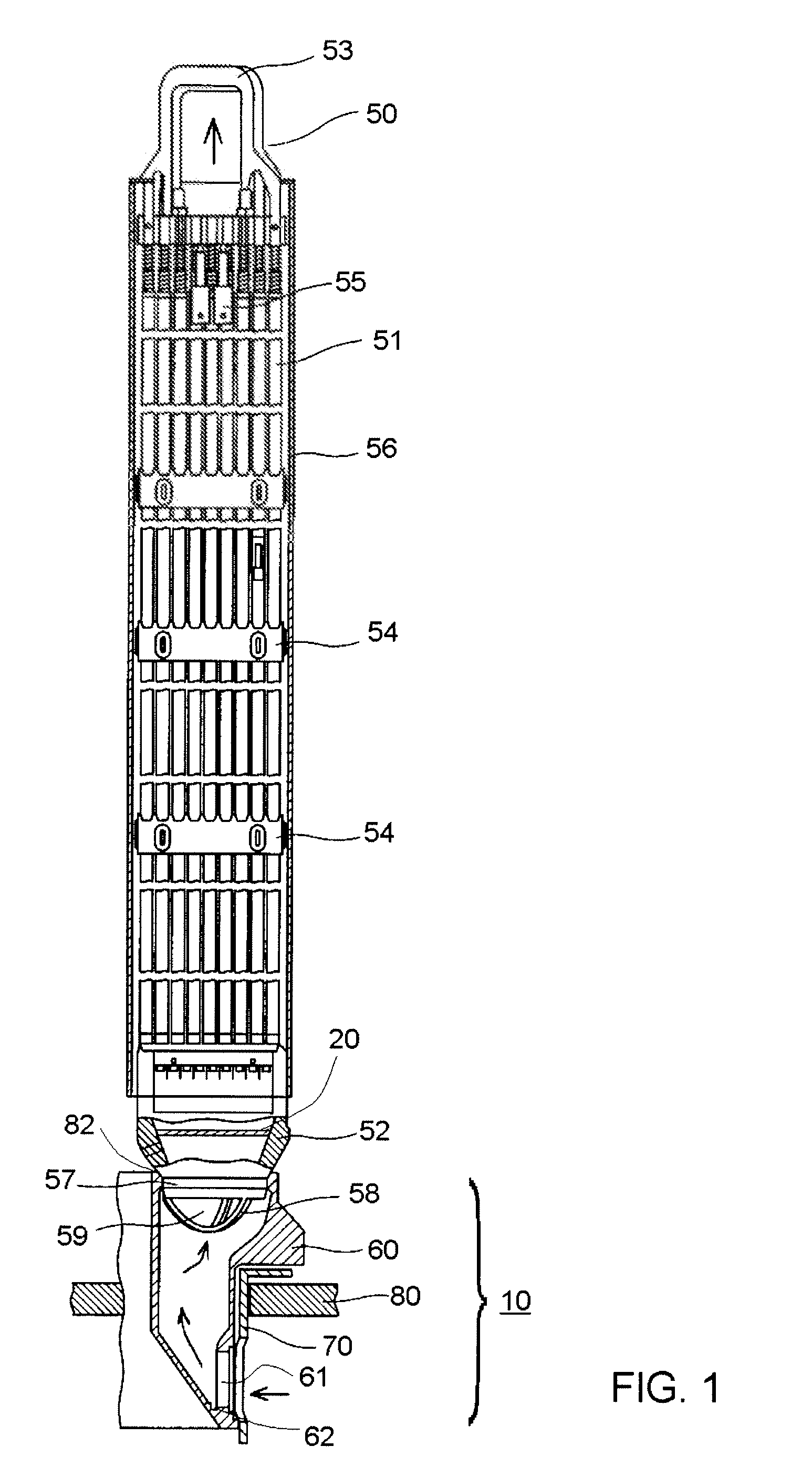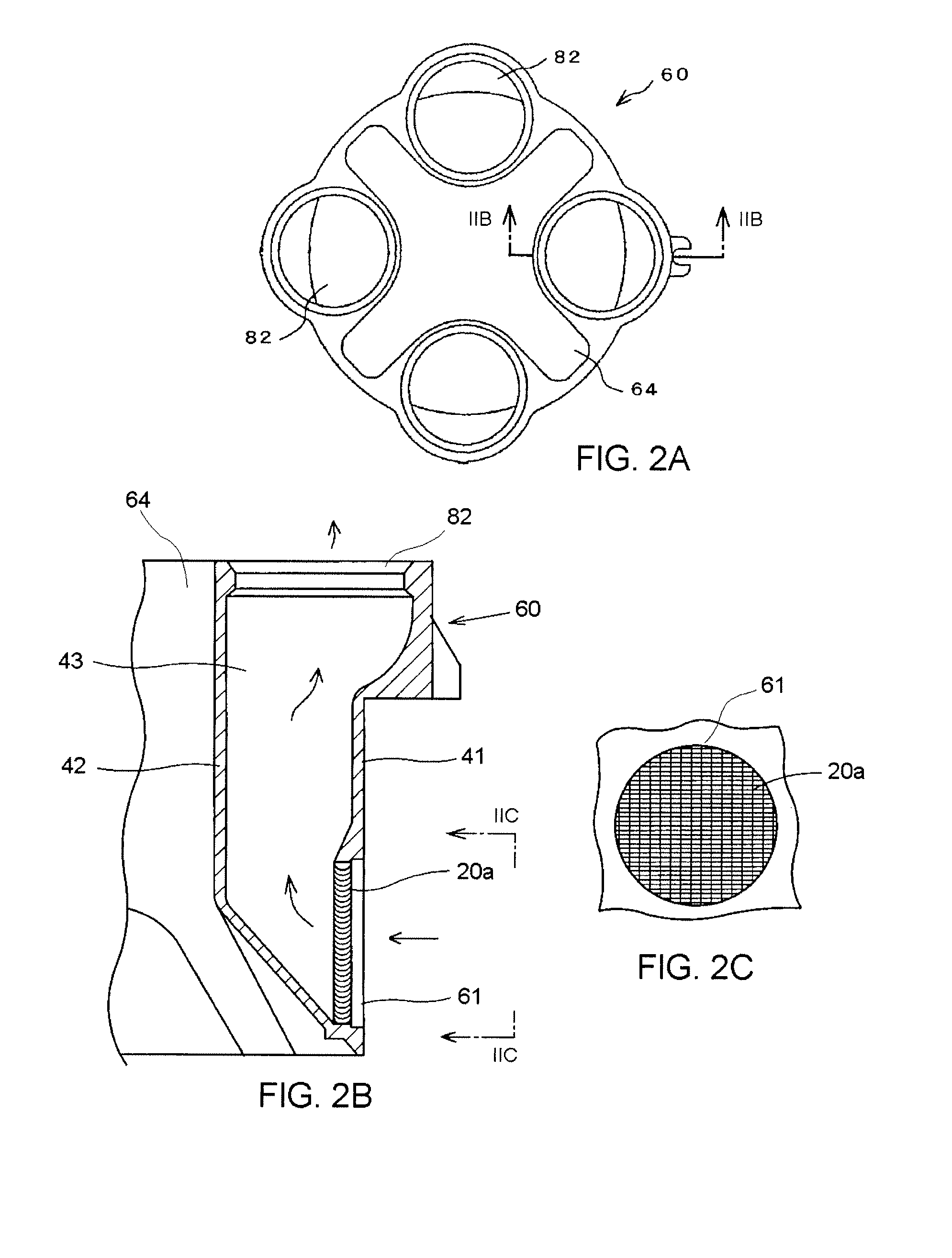Fuel supporting attachment and fuel inlet mechanism
a technology of fuel inlet mechanism and supporting attachment, which is applied in the direction of nuclear reactors, nuclear elements, greenhouse gas reduction, etc., can solve the problems of damage to the fuel rod and the fuel spacer, and increase the pressure loss of the fuel assembly. , to achieve the effect of minimizing pressure loss and simple structur
- Summary
- Abstract
- Description
- Claims
- Application Information
AI Technical Summary
Benefits of technology
Problems solved by technology
Method used
Image
Examples
first embodiment
[0054]FIG. 1 shows a fuel assembly according to a first embodiment of this invention, in which it shows an example of this embodiment being applied to a fuel assembly for a boiling water reactor. The fuel assembly 50 includes a plurality of portions of fuel rods 51 aligned in a lattice shape and a single portion or a plurality of portions of water rods 55. Lower ends and upper ends of the fuel rods 51 and water rods 55 are fixed to a lower tie plate 52 and an upper tie plate 53, respectively. There are a plurality of fuel spacers 54 between the lower tie plate 52 and the upper tie plate 53 (here only three fuel spacers are shown representatively), thereby intervals among the fuel rods 51 and the water rods 55 are maintained. Sides of the fuel assembly 50 are covered by a channel box 56, having a section approximately in a square shape, an upper end and a lower end of which are opened. An inlet nozzle 57 constituting an inlet of coolant into the fuel assembly 50 is arranged at a lowe...
second embodiment
[0056]Next, an explanation of a fuel inlet mechanism according to a second embodiment of this invention will be given in reference to FIGS. 2A, 2B and 2C. A fuel inlet mechanism 10 of this embodiment is comprised of mostly a fuel introducing attachment 60, however, the fuel inlet mechanism could be any structure introducing upstream of the fuel assembly that provides coolant into the fuel assembly.
[0057]The fuel supporting attachment 60 is mounted on the core support plate 80 as shown in FIGS. 2A, 2B and 2C, and each fuel supporting attachment 60 supports four fuel assemblies 50 from the lower side and has four openings 82 to pass the coolant into the fuel assemblies 50. In the fuel supporting attachment 60, an outer wall 41 and an inner wall 42 constitute a coolant passage 43 under the opening 82. A coolant introducing hole 61 is arranged under the outer wall 41, that is, at each gate portion of the fuel supporting attachment 60 directed toward the respective opening 82, and each c...
third embodiment
[0059]Next, an explanation of detailed structure of the above-mentioned filters 20 or 20a will be given according to a third embodiment of this invention. Structures of the filter 20 and the filter 20a are common to both filters and the following explanation will be given of the filter 20 representatively.
[0060]The filter 20 is constituted by aligning a number of passages 3 in a shape of a character V (or “Λ” lambda in the Greek alphabet, that is, a passage has a bent portion) shown in FIG. 3 in parallel. A shape of the flow path 3 viewed from a flow direction D is, for example, a rectangular shape as shown in FIG. 4A or a circular shape as shown in FIG. 4B. In the case of the rectangular hole 1 shown in FIG. 4A, a condition of catching a linear foreign substance 4 with a length L (for example, L is assumed to be about ten millimeters) in a direction orthogonal to the flow by the filter 20 is L>√(A2+B2), wherein a transverse length and a vertical length of the hole are designated by...
PUM
 Login to View More
Login to View More Abstract
Description
Claims
Application Information
 Login to View More
Login to View More - R&D
- Intellectual Property
- Life Sciences
- Materials
- Tech Scout
- Unparalleled Data Quality
- Higher Quality Content
- 60% Fewer Hallucinations
Browse by: Latest US Patents, China's latest patents, Technical Efficacy Thesaurus, Application Domain, Technology Topic, Popular Technical Reports.
© 2025 PatSnap. All rights reserved.Legal|Privacy policy|Modern Slavery Act Transparency Statement|Sitemap|About US| Contact US: help@patsnap.com



